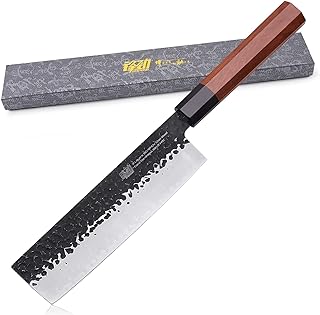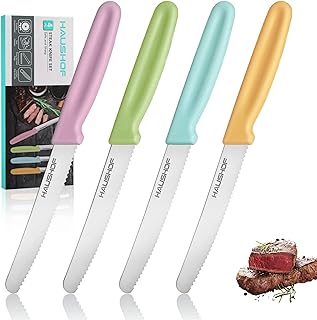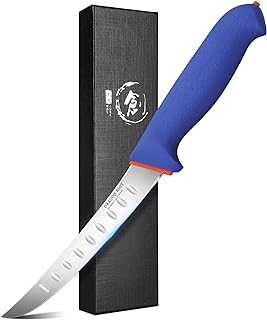5 important factors worth considering when looking for the best meat cutting knife
In today’s world of food enthusiasts, choosing a meat cutting knife is more than just about how well it works – it’s about the craftsmanship and artistry behind it. People who appreciate good food are looking to enhance their dining experiences, and the details of finding the right meat cutting knife are crucial. Every little thing, from the type of blade to the design of the handle, makes a big difference in the cooking process. When buying a meat cutting knife, it’s important to remember that it’s not just a tool for cutting, but an extension of your cooking skills. It’s about creating a strong bond between the chef and the knife to bring out the best in every dish.
See our guide to the best meat cutting knife.
Blade material
Selecting the right meat cutting knife is important, especially when it comes to the material of the blade. High-carbon stainless steel is a great choice for both professional chefs and home cooks. It is durable, keeps its sharpness, and resists corrosion, ensuring your knife stays in top condition for a long time. Keeping your knife sharp is crucial for making precise cuts that enhance the taste and texture of your meat dishes. Investing in a knife with a high-carbon stainless steel blade will bring you satisfaction in the kitchen.
However, choosing a knife with a lower-quality blade material, like low-quality steel, can lead to problems. Knives with poor blade materials can become dull, chip easily, and struggle with tough cuts of meat. Dealing with a knife that doesn’t cut well can make cooking frustrating. By focusing on the quality of the blade material in your meat cutting knife, you are improving your kitchen experience and giving yourself a tool that allows you to cook with precision and ease. Choose carefully, and let the material of your blade be the unsung hero that turns your cooking adventures into culinary successes.
Blade length
When choosing a meat cutting knife, it’s important to think about how the blade length affects its performance. A longer blade can make it easier to cut meat cleanly and accurately. It gives you more control and efficiency, making it easier to slice through different types of meat without using too much force or risking accidents. A longer blade also allows for smoother movements, resulting in evenly cut meat that looks and cooks better.
While a shorter blade might be easier to use in tight spaces, there are clear advantages to using a longer blade when working with larger cuts of meat. It can help you cut meat with more finesse and without as much effort.
It’s also important to consider your own comfort and experience when choosing a blade length. If you’re a beginner, a shorter blade might be easier to handle at first, giving you more control and precision as you practice your knife skills. But as you get more comfortable cutting meat, a longer blade can help you work faster and more efficiently in the kitchen.
In the end, the best blade length for you depends on what you prefer and the tasks you’ll be using the knife for. Whether you choose a shorter or longer blade, make sure it’s functional and comfortable to use so that cutting meat is a smooth and enjoyable experience.
Handle design
The way a meat cutting knife handle is designed is really important for how easy it is to use when slicing different types of meat. A good handle should feel nice to hold and not make your hand or wrist tired, so you can use it for a long time without any pain. Handles that are shaped well and made from good materials like wood or synthetic composites can help you have more control over the knife, so you can make cleaner cuts. On the other hand, a handle that is slippery or uncomfortable can make cutting meat harder and more dangerous because you might lose control.
It’s important to think about the handle when choosing a meat cutting knife. You should pick one that fits your hand well and works with how you like to cut. A handle that feels right in your hand can make a big difference in how much you enjoy cooking. Getting a knife with a handle that’s made well can make cooking more fun because you will feel more confident and comfortable when you’re cutting meat.
Sharpness
When choosing a knife for cutting meat, the most important factor to consider is sharpness. A sharp knife is essential for cutting meat efficiently and accurately. A sharp blade makes cutting easier and produces cleaner cuts, keeping the flavors and juices of the meat intact. On the other hand, dull knives make cutting harder, leading to jagged edges and uneven slices that can affect the presentation of your dishes.
Investing in a knife with excellent sharpness can improve your cooking experience and help you achieve professional-looking results that will impress both you and your guests. Sharp knives also play a crucial role in kitchen safety. With a sharp blade, you need less force to cut through meat, reducing the risk of accidents that can happen with dull knives.
By keeping your meat cutting knife sharp, you not only enhance the quality of your cooking but also prioritize safety in the kitchen. In conclusion, sharpness is essential when choosing a meat cutting knife, as it offers both culinary benefits and a safer kitchen environment for all your cooking endeavors.
Maintenance requirements
Taking care of your meat cutting knife is crucial for keeping it in good shape. It’s not just about having a good quality blade – you also need to make sure you maintain it properly. If you don’t take care of your knife, it won’t work as well and your cuts won’t be as good.
One important way to maintain your knife is by sharpening it regularly. This helps keep the blade sharp and ensures that your cuts are precise. Rust is a big problem for knives, so it’s important to dry your knife thoroughly and store it right away after using it to prevent corrosion.
It’s worth spending time taking care of your knife because it helps you make great meals. Cleaning your knife properly is essential. Using warm, soapy water and a gentle scrub will get rid of any leftover food without damaging the blade. Using wooden cutting boards instead of harder surfaces can help your knife last longer and make cutting easier and safer.
Remember, keeping your knife in good condition is not just about cooking – it shows your commitment to the art of cooking and helps you create delicious dishes.
Conclusion
In the culinary world, a meat cutting knife is a symbol of precision and skill. With its sharp blade, comfortable design, and seamless performance, it takes slicing and dicing to a new level. This knife is an important tool for chefs, combining functionality with tradition and expertise. Each precise cut tells a story of culinary mastery and passion, showing that knife work is essential in creating exceptional dishes. Want more info on clinometer forestry, check the best clinometer forestry.


